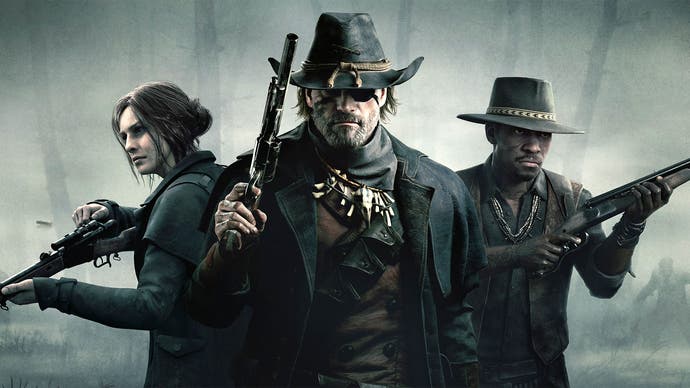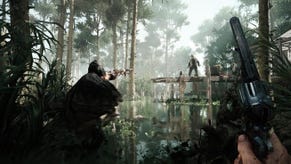Hunt: Showdown 1896's console upgrades are welcome - but need some work
A worthwhile current-gen revamp - with 60fps now the target.
Marking the game's biggest upgrade since its launch, Crytek's online FPS, Hunt: Showdown 1896 is retooled and even retitled for today's hardware. Fundamentally the game migrates to CryEngine 5.11, complete with a suite of visual upgrades, DirectX 12 support, and most crucially, a release for PlayStation 5, Xbox Series X and S. At last, this means that consoles receive real time lighting via SVOGI - Sparse Voxel Octree Global Illumination - in an enhanced form that allows both diffuse lighting and a simulation of light across rougher, specular materials. There's improved hair rendering, noticeably in the game's loadout menu. We have support for upscaling technologies like AMD's FSR and Nvidia's DLSS - where FSR2 in particular is used on consoles. Plus, there's a 60 frames per second target this time, double that of the 30fps on all last-gen PS4 and Xbox One machines. So the questions here are simple: what's the state of this latest CryEngine effort on today's best consoles? How do the three versions compare? And how successfully does each hit a stable 60fps?
In terms of the basics, PS5 and Series console owners get a free upgrade much like PC and this keeps all progress from last-gen machines. Much of its winning PvPvE design stays intact as well. As a bounty hunter, you're unleashed in an alternate USA with a supernatural twist. From Louisiana's bayou to the rocky mountains of Colorado, eldritch horrors fill out a large, desolate landscape; each mine, mill and pit teeming with zombies and giant spiders. The goal? To track down your target monster, defeat it, and collect a bounty token from its corpse - all while avoiding other online clans of up to three players.
Hunt: Showdown effectively uses CryEngine to sculpt a photorealistic landscape, built on accurately lit materials - while its horror aspect adds genuine tension as you scan for clues, or avoid enemy players. It's earned something of a cult following for good reason. Playing today, I will admit there are rough spots on consoles though: texture and enemy pop-in are still noticeable. Also, the brightness level on PS5 is much too dark by default, and did need adjusting to be able to see anything at night. It has a few visual bugs in AI pathfinding as well, but the high points of CryEngine still shine through overall.
In terms of basic tech specs, Hunt: Showdown 1896 uses a fixed resolution target on all platforms - with no dynamic scaling involved, much like the last-gen console releases. To hit a higher 60fps goal though, the targets change on current-gen machines. On Series X we have 1440p as the set internal target, which is then scaled up to 4K using AMD's FSR 2. Next, PS5 renders at a lower resolution of 1260p, again using FSR 2 for a 4K upscale. And finally, Series S pushes a native 864p image here, resulting in another step down in overall image clarity. For Series S, it's worth stressing that FSR 2 is only able to do so much to resolve a higher resolution final frame from an 864p base. Given the huge scale of Hunt: Showdown's maps, there are moments where distant sub-pixel detail is only really visible at a close range on Series S. Also, the fact that DRS isn't currently used on any machine here does have some bearing on performance - notably on Series X, which does struggle to support all its new CryEngine features at its fixed 1440p.
In terms of core visuals these three show some key differences. The game deploys matching shadow quality for all three, and likewise, screen-space reflections run at an equivalent resolution on each, with a cubemap texture used as a fallback measure. Now, often we see PS5 and Series X are a settings match but there is one curious omission on PS5 this time, in that volumetric effects are missing on Sony's console. Even Series S has these enabled - where it's hard to miss the long streaks of light piercing through the cracks of barns, illuminating the dust in the centre, all present on both Xbox consoles. Perhaps this is a bug - an oversight on Crytek's part. And in fairness, lens flares and soft light shafts are engaged on PS5 in exterior areas. For better or worse in frame-rate performance, it's a missing feature for now around interiors. Otherwise, besides the missing volumetric effects, the gamma difference, and the different resolutions - 1260p vs 1440p - PS5 and Series X are a match in core settings. Texture quality, foliage draw, parallax occlusion maps, it's all there in equal measure.
Series S has a few more cutbacks. Besides the drop to 864p, texture quality is reduced with lower grade assets across the ground, weaponry, and objects. Anisotropic filtering is of a lower quality, and parallax occlusion mapping is pared back at points. The volumetric lighting is also reduced in resolution compared to its 12TF brother, but still preferable to its omission on PS5. Beyond that, Series S also drops the draw distance setting for upcoming foliage and the quality of alpha effects, especially for fire, are lowered. On the whole, it does still hold up well by comparison - and many of these quality reductions are less noticeable as the game is viewed through a lower resolution window.
Moving on to performance, Hunt: Showdown 1896 targets 60 frames per second on all three consoles with no quality mode selection: you get one way to play. The hope, then, is that a concerted push for one mode yields a more tightly optimised experience, except looking at Series X that's not quite the case. Series X is the worst performer of the three overall. You do get to 60fps most of the time, but it's punctuated by clear, obvious drops during play. Firstly, any time you switch to Dark Sight vision - a major game mechanic used to track down clues and enemies - you'll incur a momentary blip. A cluster of frames are dropped in each transition between view mode, essentially, similar to what we saw on last-gen consoles. More glaring still, looking directly at a target while in Dark Sight view heavily drops frames on Series X, with a lurching 45-60fps range. Engaging Dark Sight right next to a target shows these drops at their most extreme: a repeat pattern that holds for as long as you keep it active.
It's a shame given that using Dark Sight is crucial to victory. A VRR display will help to perceptually smooth out these drops, given that they rarely go below 45fps, but that's not a luxury available to everyone. Likewise, Series X has issues in general open field play. Long views over huge terrain - the swamps, the mills - at times incur a drop into the 50s, and indeed anything involving complex settlements is a trigger. It's not always the case, and typically it holds at 60fps, but drops happen often enough to distract. Even scoping with a long range rifle, quickly zooming in and out across the map, cues a sudden drop as the renderer adjusts, to draw in more detail. And finally, sudden bursts of alpha effects - the fire, blood or a swarm of insects - drop Series X into the 50-60fps region as well. Again VRR saves the day, but for those without, the machine is struggling against the characteristics of the engine. In every case where there's a drop, expect some screen tear at the top of the display on both Xbox consoles.
Next along we have the PS5 version. The drop from Xbox Series X's 1440p native resolution to a lesser 1260p is a factor in performance here, as is, potentially, the missing volumetrics. First up, the Dark Sight view no longer shows as many erratic drops to the high-40s. Rather, PS5 often runs similar scenarios at a plain 60fps. Already then we're at an advantage. Jumping in and out of this view mode sadly incurs similar hitches on Sony's machine, but sustained drops beyond that point are less drastic. It's not a perfect delivery by any means but it's a night and day difference next to Series X. Next along, there's the broad long views of swamps and outposts, and in matching tests using its tutorial, PS5 again clears most routes at a clean 60fps - where Series X drops to 55fps. This bears out in regular action as well, with fewer drops when faced with a complex scene.
The one point where PS5 suffers is in facing heavy alpha effects like fire: drops to the mid-50s are possible here, and unfortunately PS5 has screen tearing run up and down the entire display, unlike Xbox consoles which constrain the tears to the top 20 per cent. In short, PS5 runs at a lower resolution, it potentially has more visible tearing, but it's less prone to frame-rate drops and hitches overall.
Last up is the Series S. The lower native resolution, the reduced draw, texture quality, parallax occlusion maps, alpha effects and volumetrics all amount to a version that (perhaps surprisingly) runs better than the more powerful Series X. Some might say It almost overcompensates with dropped settings, with far fewer drops in the very same hot spots compared to Series X. Where Series S does have struggles though is in handling complex, open scenery and - yes - the Dark Sight view. Generally, Series S runs less smoothly than PS5, but a touch faster than Series X, so let's just say it has its own set of pros and cons. The dropped settings qualify it for better frame-rates around effects-heavy action, which is an advantage over PS5 and Series X but it still has similar issues with rendering complex scenes from afar.
On balance, Hunt: Showdown 1896's reinvention for current-gen machines is a mixed bag. It's a shame to see the frequency of frame-rate drops, below 60, given the time it's been in development. VRR might be just the thing to save Xbox Series X in particular - though Series S and PS5 will benefit in different scenarios from that as well. Still, it's a surprise that, for all the new features added with CryEngine 5.11, and with the move to much more powerful hardware, a locked 60fps simply isn't in view. Despite the shortfalls on consoles we're seeing today, it's encouraging to see the team supporting the game and the community that's grown around it all these years later. With that in mind, I really do hope Crytek is able to keep pushing, to tighten up the results we're seeing here - based on the spread across the consoles, there's the sense that small changes could yield significant results.










